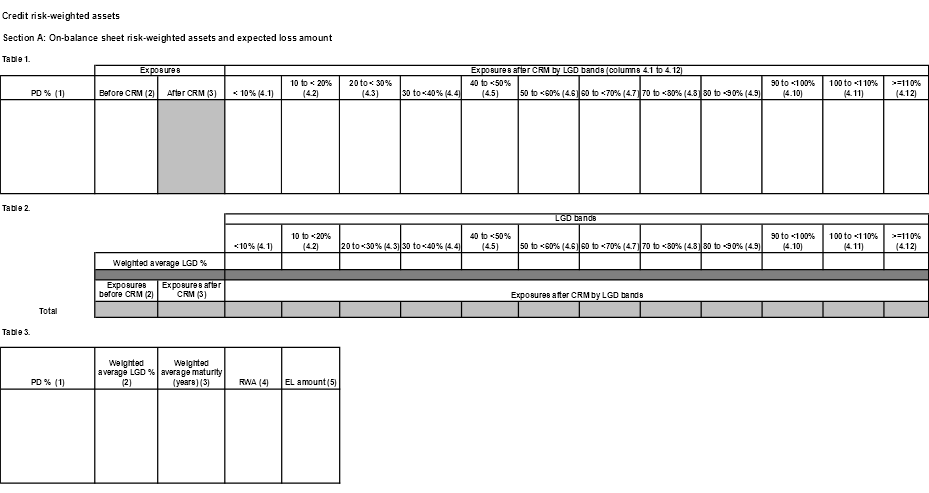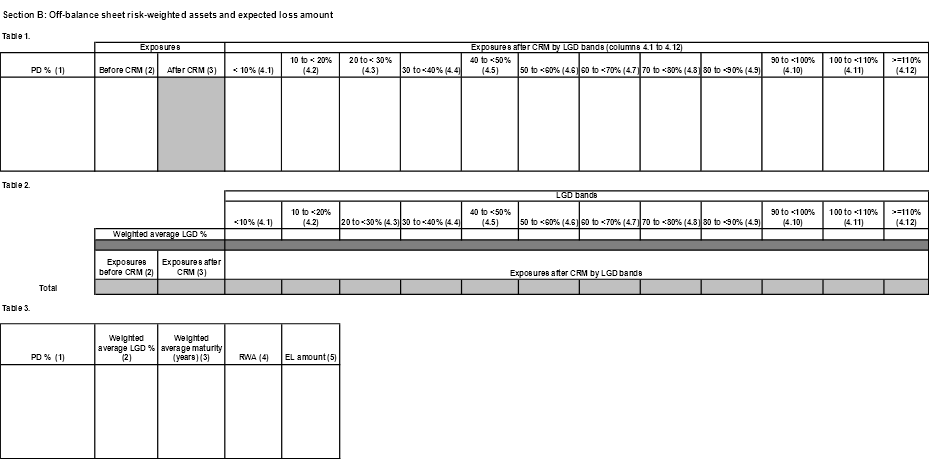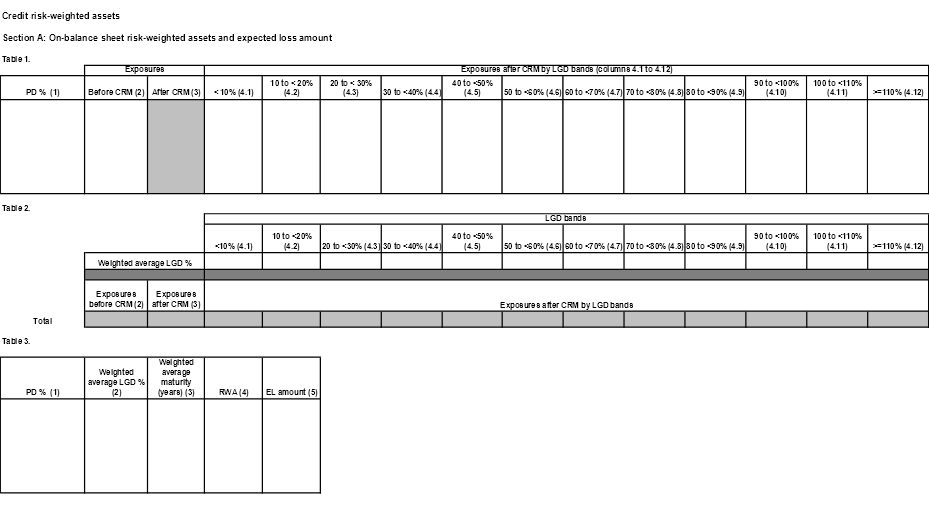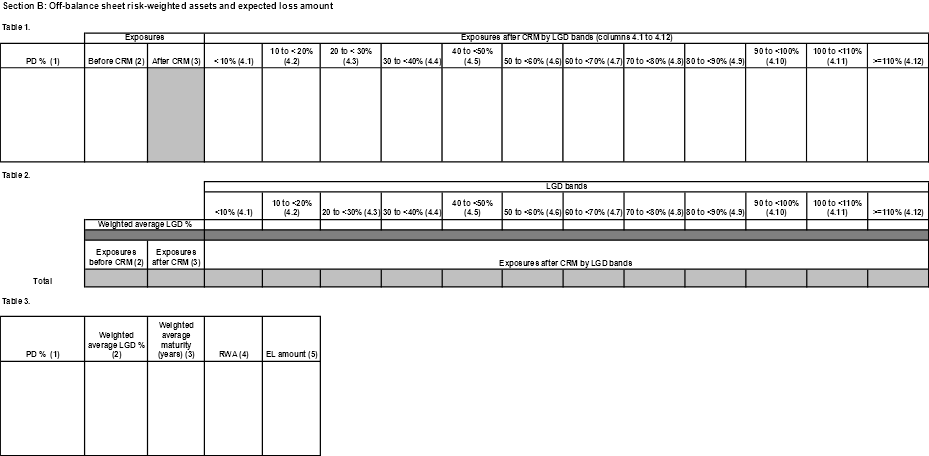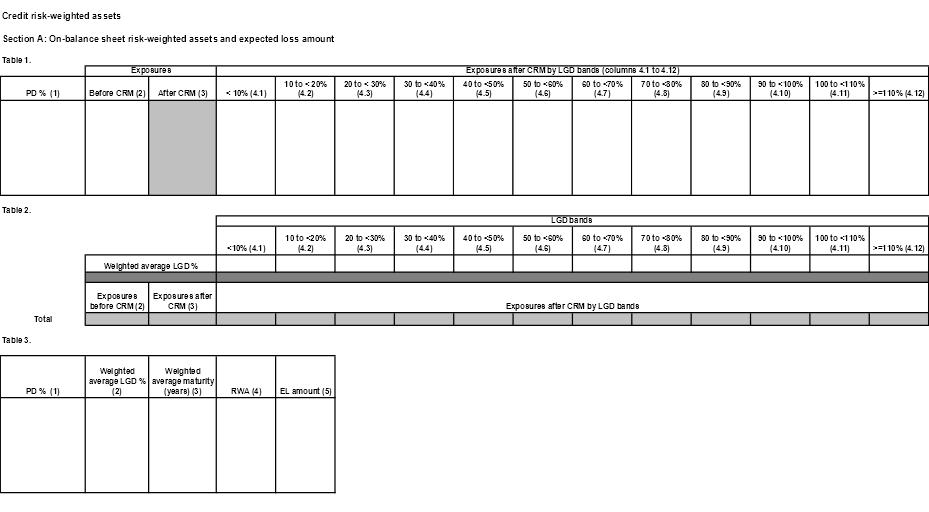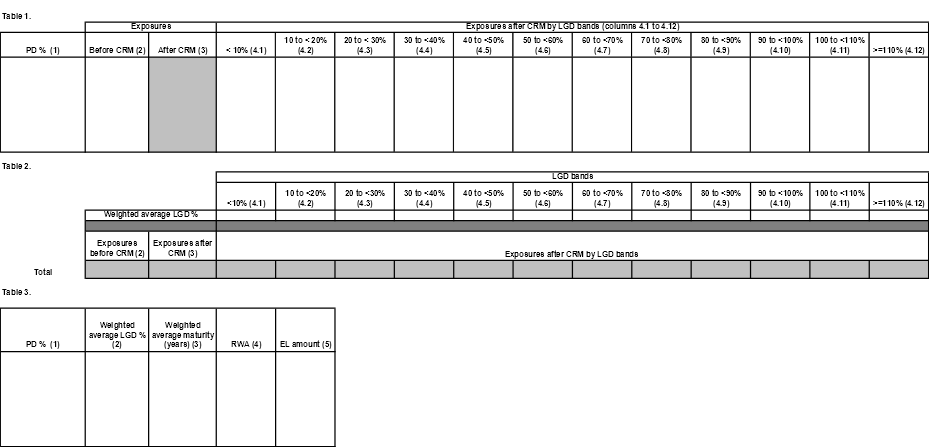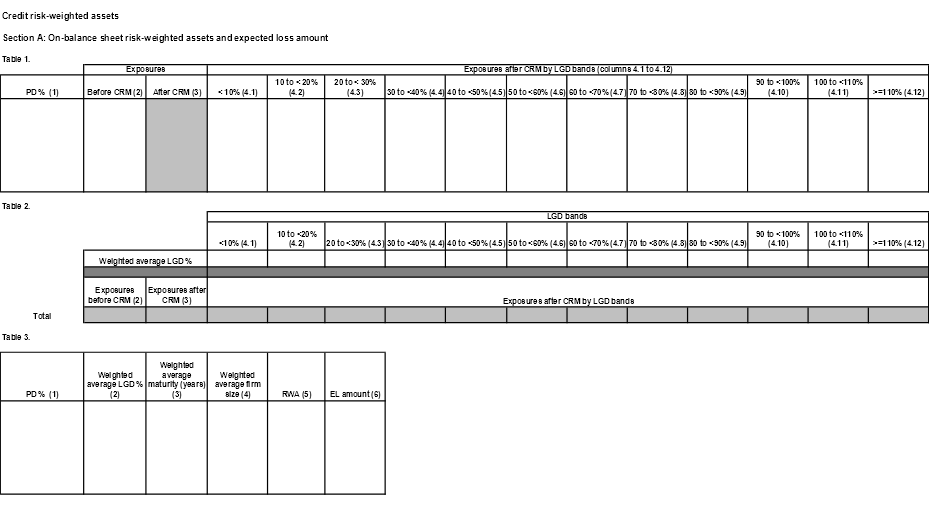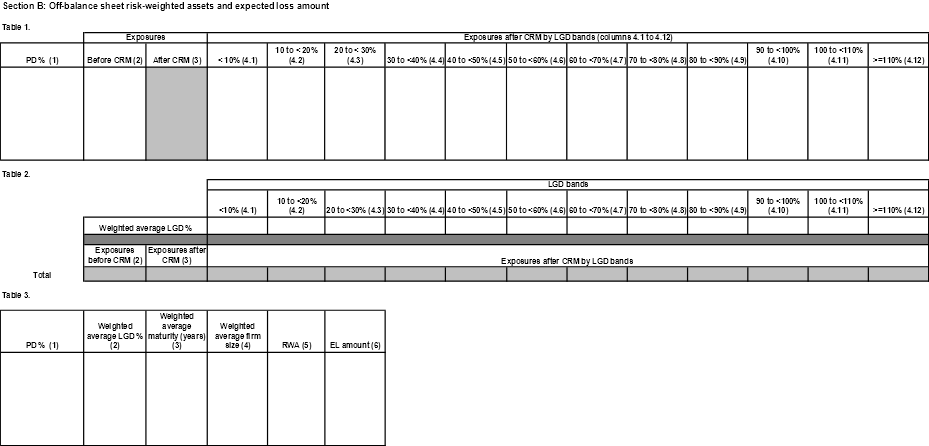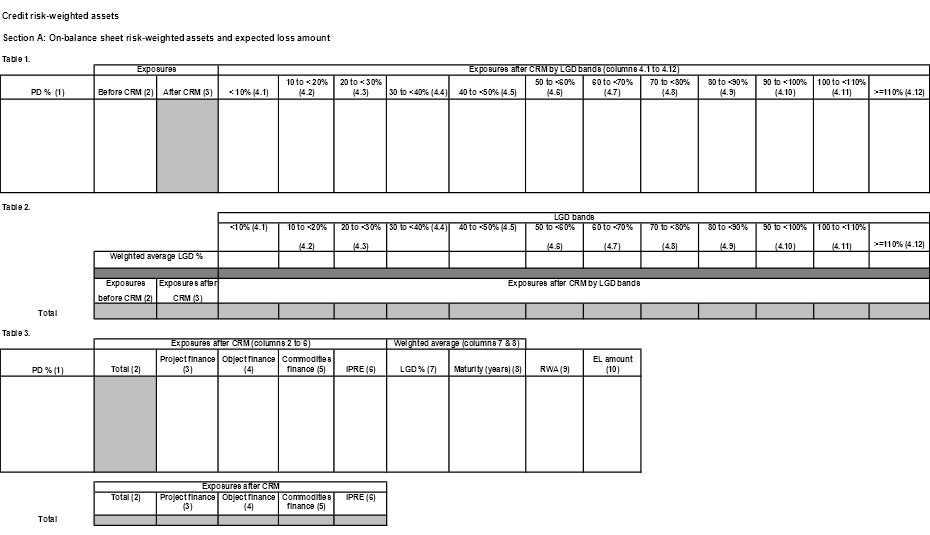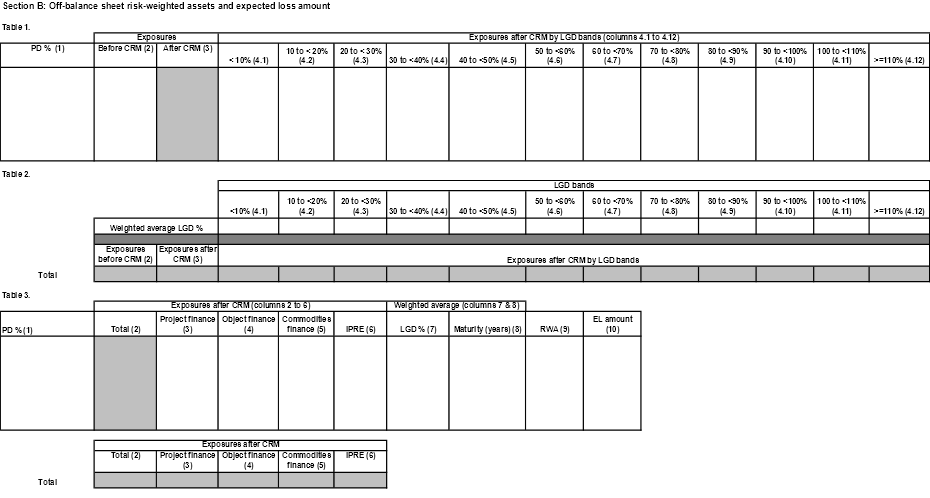
Financial Sector (Collection of Data) (reporting standard) determination No. 4 of 2018
Reporting Standard ARS 113.1 Advanced Internal Ratings-based (AIRB) Approach to Credit Risk
Financial Sector (Collection of Data) Act 2001
I, Alison Bliss, delegate of APRA, under paragraph 13(1)(a) of the Financial Sector (Collection of Data) Act 2001 (the Act) and subsection 33(3) of the Acts Interpretation Act 1901:
(a) REVOKE Financial Sector (Collection of Data) (reporting standard) determination No. 5 of 2008, including Reporting Standard ARS 113.1 Advanced Internal Ratings-based (AIRB) Approach to Credit Risk made under that Determination; and
(b) DETERMINE Reporting Standard ARS 113.1 Advanced Internal Ratings-based (AIRB) Approach to Credit Risk, in the form set out in the Schedule, which applies to the financial sector entities to the extent provided in paragraph 3 of the reporting standard.
Under section 15 of the Act, I DECLARE that the reporting standard shall begin to apply to those financial sector entities, and the revoked reporting standard shall cease to apply, on 1 April 2018.
This instrument commences on 1 April 2018.
Dated: 21 March 2018
[Signed]
Alison Bliss
General Manager
Data Analytics Division
Interpretation
In this Determination:
APRA means the Australian Prudential Regulation Authority.
financial sector entity has the meaning given by section 5 of the Act.
Schedule

Reporting Standard ARS 113.1
Advanced Internal Ratings-based (AIRB) Approach to Credit Risk
This Reporting Standard is made under section 13 of the Financial Sector (Collection of Data) Act 2001.
This Reporting Standard outlines the overall requirements for the provision of information to APRA in relation to an authorised deposit-taking institution’s corporate (including specialised lending and SME corporate), sovereign and bank exposures under the advanced internal ratings-based approach to credit risk. It should be read in conjunction with:
- the versions of Reporting Form ARF 113.1A AIRB - Corporate, Reporting Form ARF 113.1B AIRB – Sovereign, Reporting Form ARF 113.1C AIRB – Bank, Reporting Form ARF 113.1D AIRB – SME Corporate and Reporting Form ARF 113.1E AIRB – Specialised Lending designated for an authorised deposit-taking institution reporting at Level 1 and Level 2, and the associated instructions (all of which are attached and form part of this Reporting Standard); and
- Prudential Standard APS 113 Capital Adequacy: Internal Ratings-based Approach to Credit Risk.
Authority
- This Reporting Standard is made under section 13 of the Financial Sector (Collection of Data) Act 2001.
Purpose
2. Data collected in Reporting Form ARF 113.1A AIRB - Corporate (ARF 113.1A), Reporting Form ARF 113.1B AIRB – Sovereign (ARF 113.1B), Reporting Form ARF 113.1C AIRB - Bank (ARF 113.1C), Reporting Form ARF 113.1D AIRB – SME Corporate (ARF 113.1D) and Reporting Form ARF 113.1E AIRB – Specialised Lending (ARF 113.1E) is used by APRA for the purpose of prudential supervision, including assessing compliance with Prudential Standard APS 113 Capital Adequacy: Internal Ratings-based Approach to Credit Risk (APS 113). It may also be used by the Reserve Bank of Australia (RBA) and the Australian Bureau of Statistics (ABS).
Application and commencement
3. This Reporting Standard applies to an authorised deposit-taking institution (ADI) that has APRA’s approval or is seeking APRA’s approval to use the advanced internal ratings-based approach to credit risk for capital adequacy purposes.
This Reporting Standard may also apply to the non-operating holding company (NOHC) of an ADI (refer to paragraph 6).
4. This Reporting Standard commences on 1 April 2018.
Information required
5. An ADI to which this Reporting Standard applies must provide APRA with the information required by the versions of ARF 113.1A, ARF 113.1B, ARF 113.1C, ARF 113.1D and ARF 113.1E designated for an ADI at Level 1 for each reporting period.
6. If an ADI to which this Reporting Standard applies is part of a Level 2 group, the ADI must also provide APRA with the information required by the versions of ARF 113.1A, ARF 113.1B, ARF 113.1C, ARF 113.1D and ARF 113.1E designated for an ADI at Level 2 for each reporting period, unless the ADI is a subsidiary of an authorised NOHC. If the ADI is a subsidiary of an authorised NOHC, the ADI’s immediate parent NOHC must provide APRA with the information required by that form for each reporting period. In doing so, the immediate parent NOHC must comply with this Reporting Standard (other than paragraphs 5 and 12) as if it were the relevant ADI.
Forms and method of submission
7. The information required by this Reporting Standard must be given to APRA in electronic format, using the ‘Direct to APRA’ application or by a method notified by APRA, in writing, prior to submission.
Note: the Direct to APRA application software (also known as D2A) may be obtained from APRA.
Reporting periods and due dates
8. Subject to paragraph 9, an ADI to which this Reporting Standard applies must provide the information required by this Reporting Standard for each quarter based on the financial year (within the meaning of the Corporations Act 2001) of the ADI.
9. APRA may, by notice in writing, change the reporting periods, or specified reporting periods, for a particular ADI, to require it to provide the information required by this Reporting Standard more frequently, or less frequently, having regard to:
(a) the particular circumstances of the ADI;
(b) the extent to which the information is required for the purposes of the prudential supervision of the ADI; and
(c) the requirements of the Reserve Bank of Australia or the Australian Bureau of Statistics.
10. The information required by this Reporting Standard must be provided to APRA within 30 business days after the end of the reporting period to which the information relates.
11. APRA may grant an ADI an extension of a due date in writing, in which case the new due date for the provision of the information will be the date on the notice of extension.
Quality control
12. All information provided by an ADI under this Reporting Standard (except for the information required under paragraph 6) must be the product of systems, processes and controls that have been reviewed and tested by the external auditor of the ADI as set out in Prudential Standard APS 310 Audit and Related Matters. Relevant standards and guidance statements issued by the Auditing and Assurance Standards Board provide information on the scope and nature of the review and testing required from external auditors. This review and testing must be done on an annual basis or more frequently if required by the external auditor to enable the external auditor to form an opinion on the accuracy and reliability of the information provided by an ADI under this Reporting Standard.
13. All information provided by an ADI under this Reporting Standard must be subject to processes and controls developed by the ADI for the internal review and authorisation of that information. These systems, processes and controls are to assure the completeness and reliability of the information provided.
Authorisation
14. When an officer of an ADI submits information under this Reporting Standard using the D2A application, or other method notified by APRA, it will be necessary for the officer to digitally sign the relevant information using a digital certificate acceptable to APRA.
Minor alterations to forms and instructions
15. APRA may make minor variations to:
(a) a form that is part of this Reporting Standard, and the instructions to such a form, to correct technical, programming or logical errors, inconsistencies or anomalies; or
(b) the instructions to a form, to clarify their application to the form
without changing any substantive requirement in the form or instructions.
16. If APRA makes such a variation it must notify in writing each ADI that is required to report under this Reporting Standard.
Interpretation
17. In this Reporting Standard:
AASB has the meaning in section 9 of the Corporations Act 2001.
ADI means an authorised deposit-taking institution within the meaning of the Banking Act 1959.
APRA means the Australian Prudential Regulation Authority established under the Australian Prudential Regulation Authority Act 1998.
authorised NOHC has the meaning given in the Banking Act 1959.
business days means ordinary business days, exclusive of Saturdays, Sundays and public holidays.
immediate parent NOHC means an authorised NOHC, or a subsidiary of an authorised NOHC, that is an immediate parent NOHC within the meaning of paragraph 21(b) of Prudential Standard APS 110 Capital Adequacy (APS 110).
Level 1 has the meaning in APS 001.
Level 2 has the meaning in APS 001.
reporting period means a period mentioned in paragraph 8 or, if applicable, paragraph 9.
subsidiary has the meaning in section 9 of the Corporations Act 2001.
18. Unless the contrary intention appears, a reference to an Act, Prudential Standard, Reporting Standard, Australian Accounting or Auditing Standard is a reference to the instrument as in force from time to time.

Reporting Forms ARF 113.1A, ARF 113.1B, ARF 113.1C and ARF 113.1D
AIRB – Corporate (including SME Corporate), Sovereign and Bank
Instruction Guide
This instruction guide is designed to assist in the completion of the AIRB – Corporate, Sovereign, Bank and SME Corporate suite of forms. This suite of forms consists of the following:
(a) Reporting Form ARF 113.1A AIRB – Corporate (ARF 113.1A);
(b) Reporting Form ARF 113.1B AIRB – Sovereign (ARF 113.1B);
(c) Reporting Form ARF 113.1C AIRB – Bank (ARF 113.1C); and
(d) Reporting Form ARF 113.1D AIRB – SME Corporate (ARF 113.1D).
These forms capture the credit risk-weighted assets (RWA) and risk components of corporate (excluding specialised lending), sovereign, bank and small- and medium-sized enterprise (SME) corporate exposures under the advanced internal ratings-based (AIRB) approach to credit risk. In completing these forms, authorised deposit-taking institutions (ADIs) should refer to Prudential Standard APS 113 Capital Adequacy: Internal Ratings-based Approach to Credit Risk (APS 113). There is a separate instruction guide for Reporting Form ARF 113.1E AIRB – Specialised Lending.
General directions and notes
Reporting entity
These forms are to be completed at Level 1 and Level 2 by each ADI (subject to the following paragraph) that has APRA’s approval or is seeking APRA’s approval to use the AIRB approach to credit risk for its corporate (including SME corporate), sovereign and/or bank IRB asset classes, or to certain exposures within such an asset class, for capital adequacy purposes, in accordance with APS 113.
If an ADI is a subsidiary of an authorised non-operating holding company (NOHC), the report at Level 2 is to be provided by the ADI’s immediate parent NOHC.
Securitisation deconsolidation principle
Except as otherwise specified in these instructions, the following applies:
- Where an ADI (or a member of its Level 2 consolidated group) participates in a securitisation that meets APRA’s operational requirements for regulatory capital relief under Prudential Standard APS 120 Securitisation (APS 120):
(a) special purpose vehicles (SPVs) holding securitised assets may be treated as non-consolidated independent third parties for regulatory reporting purposes, irrespective of whether the SPVs (or their assets) are consolidated for accounting purposes;
(b) the assets, liabilities, revenues and expenses of the relevant SPVs may be excluded from the ADI’s reported amounts in APRA’s regulatory reporting returns; and
(c) the underlying exposures (i.e. the pool) under such a securitisation may be excluded from the calculation of the ADI’s regulatory capital (refer to APS 120). However, the ADI must still hold regulatory capital for the securitisation exposures that it retains or acquires and such exposures are to be reported in Reporting Form ARF 120.1 Securitisation – Regulatory Capital. The RWA relating to such securitisation exposures must also be reported in Reporting Form ARF 110.0.1 Capital Adequacy (Level 1) and Reporting Form ARF 110.0.2 Capital Adequacy (Level 2).
2. Where an ADI (or a member of its Level 2 consolidated group) participates in a securitisation that does not meet APRA’s operational requirements for regulatory capital relief under APS 120, or the ADI undertakes a funding-only securitisation or synthetic securitisation, such exposures are to be reported as on-balance sheet assets in APRA’s regulatory reporting returns. In addition, these exposures must also be reported as a part of the ADI’s total securitised assets within Reporting Form ARF 120.2 Securitisation – Supplementary Items.
Reporting period and timeframe for lodgement
These forms are to be completed as at the last day of the stated reporting period (i.e. the relevant quarter) and submitted to APRA within 30 business days after the end of the relevant reporting period.
Requirements applying to certain ADIs reporting under the forms
The following particular requirements apply to certain ADIs:
Description of ADI | Reporting requirement | Timeframe for lodgement |
ADI is operating under Prudential Standard APS 112 Capital Adequacy: Standardised Approach to Credit Risk (APS 112) standardised approach, but has applied to adopt (or APRA has indicated that it proposes to approve it for) the AIRB approach for most or all of its operations | Report under ARF 113.1A, ARF 113.1B, ARF 113.1C and ARF 113.1D (the forms) in respect of any relevant operations to be covered by the AIRB approach (for purposes of assessing prospective credit risk component of regulatory capital calculation after AIRB approval (i.e. “parallel run” of data)) | Within 30 business days of end of reporting period |
ADI has AIRB approval, but some operations remain under the standardised approach set out in APS 112 | Report under the forms in respect of any relevant operations that are under the AIRB approach (for purposes of calculating credit risk component of regulatory capital) | Within 30 business days of end of reporting period |
These ADIs will also have certain reporting obligations under Reporting Form ARF 112.1A Standardised Credit Risk – On-balance Sheet Assets and Reporting Form ARF 112.2A Standardised Credit Risk – Off-balance Sheet Exposures.
Unit of measurement
These forms are to be completed in millions of Australian dollars (AUD) rounded to one decimal place, unless otherwise specified in this instruction guide.
Amounts denominated in foreign currency are to be converted to AUD in accordance with AASB 121 The Effects of Changes in Foreign Exchange Rates.
Scope
An ADI is to report in ARF 113.1A, ARF 113.1B, ARF 113.1C and ARF 113.1D:
- all on-balance sheet and off-balance sheet corporate (excluding specialised lending), sovereign, bank and SME corporate exposures in its banking book that are subject to the AIRB approach, including those that expose the ADI to counterparty credit risk, except the following specifically excluded items (refer to APS 113):
(a) assets or investments that are required to be deducted from Tier 1 or Tier 2 capital under Prudential Standard APS 111 Capital Adequacy: Measurement of Capital; and
(b) securitisation exposures, which are subject to the requirements of APS 120; and
2. all trading book exposures (for the relevant asset/sub-asset classes) that expose the ADI to counterparty credit risk (refer to APS 113).
Definitions
In this instruction guide and its corresponding reporting forms (ARF 113.1A, ARF 113.1B, ARF 113.1C and ARF 113.1D), the following expressions have the defined meanings as set out below:
Corporate, sovereign and bank exposures
Refer to APS 113 for the definitions of corporate, sovereign and bank exposures.
SME corporate exposures
An SME corporate exposure is defined as a credit obligation of a corporation, partnership or proprietorship that forms a part of a corporate group that has reported consolidated annual sales of less than AUD 50 million (refer to Attachment B to APS 113).
Specific instructions
The following instructions are applicable at Level 1 and (where relevant) Level 2.
These forms do not calculate the RWA and expected loss (EL) amounts. An ADI completing these forms is required to disclose these data items based on the outputs of its own regulatory capital calculations.
Section A: On-balance sheet risk-weighted assets and expected loss amount
Table 1.
Column 1. PD
Report the assigned probability of default (PD), as a percentage rounded to two decimal places, of each obligor grade. Where PDs are bucketed and there are multiple assigned PDs within a bucket, ADIs are to report the exposure weighted average PD of the bucket.
A PD of 100 per cent is to be assigned to all defaulted exposures.
Column 2. Exposures before CRM
Exposure at default (EAD) estimates are to be calculated in accordance with the AIRB approach detailed in Attachment B to APS 113.
Report exposures before credit risk mitigation (CRM) for each assigned PD in the relevant rows.
Column 3. Exposures after CRM
Derived field that sums up the Exposures after CRM by LGD bands (columns 4.1 to 4.12) for an assigned PD.
Columns 4.1 to 4.12 Exposures after CRM by LGD bands
Refer to Attachment B to APS 113 for details of the AIRB approach to the recognition of CRM.
For reporting purposes, loss given default (LGD) bands have been pre-defined within the forms. An ADI’s LGD estimates are to be grouped into these specified LGD bands. LGD estimates are to be calculated in accordance with Attachment B to APS 113.
Report exposures after CRM in columns 4.1 to 4.12. Exposures are to be allocated to the row for the relevant assigned PD and the column for the appropriate LGD band, based on an ADI’s own internal estimates of PD and LGD.
Table 2.
Row - Weighted average LGD
Report the exposure weighted average LGD, as a percentage rounded to two decimal places, for exposures allocated to each LGD band.
Weighted average LGD =  LGDi x EAD i /
LGDi x EAD i /  EAD i
EAD i
Total
Derived fields that capture the total Exposures before CRM, Exposures after CRM and Exposures after CRM by LGD bands by summing up the exposures reported in the corresponding columns of Table 1 of this section.
Table 3.
Column 1. PD
Refer to the instructions for Table 1 in section A of this instruction guide.
Column 2. Weighted average LGD
Report the exposure weighted average LGD, as a percentage rounded to two decimal places, for exposures allocated to each assigned PD in the relevant rows.
Weighted average LGD =  LGDi x EAD i /
LGDi x EAD i /  EAD i
EAD i
Column 3. Weighted average maturity
Report the exposure weighted average effective maturity (M), in years rounded to one decimal place, for exposures allocated to each assigned PD in the relevant rows.
Weighted average maturity =  Mi x EAD i /
Mi x EAD i /  EAD i
EAD i
Column 4. Weighted average firm size (ARF 113.1D only)
This section is relevant only to ARF 113.1D.
Report the exposure weighted average firm size for exposures allocated to each assigned PD in the relevant rows.
Weighted average firm size =  Salesi x EAD i /
Salesi x EAD i /  EAD i
EAD i
Column 4. (Column 5 in ARF 113.1D) RWA
RWA are to be calculated in accordance with Attachment B to APS 113. Report the sum of RWA for exposures allocated to each assigned PD in the relevant rows.
Column 5. (Column 6 in ARF 113.1D) EL amount
EL amounts are to be calculated in accordance with APS 113. Report the sum of the EL amounts for exposures allocated to each assigned PD in the relevant rows.
Section B: Off-balance sheet risk-weighted assets and expected loss amount
Off-balance sheet exposures include both non-market-related (including undrawn commitments) and market-related off-balance sheet transactions.
Table 1.
Refer to the instructions for Table 1 in section A of this instruction guide for the following items:
(a) Column 1. PD;
(b) Column 2. Exposures before CRM;
(c) Column 3. Exposures after CRM; and
(d) Columns 4.1 to 4.12. Exposures after CRM by LGD bands.
Refer to Attachment B to APS 113 for further details on the calculation of EAD for off-balance sheet exposures.
Table 2.
Refer to the instructions for Table 2 in section A of this instruction guide for the following items:
(a) Row – Weighted average LGD; and
(b) Total.
Table 3.
Refer to the instructions for Table 3 in section A of this instruction guide for the following items:
(a) Column 1. PD;
(b) Column 2. Weighted average LGD;
(c) Column 3. Weighted average maturity;
(d) Column 4. Weighted average firm size (ARF 113.1D only);
(e) Column 4. (Column 5. in ARF 113.1D) RWA; and
(f) Column 5. (Column 6. in ARF 113.1D) EL amount.
Table 4. Memorandum items: breakdown of non-market-related off-balance sheet exposures
Report the breakdown of non-market-related off-balance sheet exposures, for which an ADI uses its own internal estimates of credit conversion factors (CCFs) under the AIRB approach (refer to Attachment B to APS 113).
Column 1. Nature of transaction
Report the nature of the non-market-related off-balance sheet transactions (e.g. commitments, direct credit substitutes, performance-related contingencies (refer to Attachment B to APS 113 for further details)). This field is limited to 80 characters.
Column 2. Notional amount
Report the notional amount (or the undrawn amount in the case of undrawn commitments) of off-balance sheet exposures after CRM in the relevant row for each transaction type listed in column 1.
Column 3. Credit equivalent amount
The credit equivalent amount is calculated by multiplying the notional amount/undrawn amount of off-balance sheet exposures for a transaction type by the appropriate CCF (refer to Attachment B to APS 113). Report the credit equivalent amounts in the relevant row for each transaction type.
Section C: Summary
Column 1. Weighted average PD
Report the exposure weighted average PD, as a percentage rounded to two decimal places, for the non-defaulted on-balance sheet and off-balance sheet exposures in the relevant rows.
Total
Report the exposure weighted average PD, as a percentage rounded to two decimal places, for the total non-defaulted exposures within the asset/sub-asset class to which the form relates.
Column 2. Weighted average LGD
Report the exposure weighted average LGD, as a percentage rounded to two decimal places, for the non-defaulted on-balance sheet and off-balance sheet exposures in the relevant rows.
Total
Report the exposure weighted average LGD, as a percentage rounded to two decimal places, for the total non-defaulted exposures within the asset/sub-asset class to which the form relates.
Column 3. Weighted average maturity
Report the exposure weighted average maturity, in years rounded to one decimal place, for the non-defaulted on-balance sheet and off-balance sheet exposures in the relevant rows.
Total
Report the exposure weighted average maturity, in years rounded to one decimal place, for the total non-defaulted exposures within the asset/sub-asset class to which the form relates.
Column 4. Weighted average firm size (ARF 113.1D only)
Report the exposure weighted average firm size, in millions of dollars rounded to one decimal place, for the non-defaulted on-balance sheet and off-balance sheet SME corporate exposures in the relevant rows.
Total
Report the exposure weighted average firm size, in millions of dollars rounded to one decimal place, for the total non-defaulted SME corporate exposures.
Column 4. RWA (Column 5 in ARF 113.1D)
Derived fields that sum up the RWA for the on-balance sheet and off-balance sheet exposures reported in Tables 3 of section A and section B respectively.
Total
Derived field that sums up the RWA for the total on-balance sheet and off-balance sheet exposures within the asset/sub-asset class to which the form relates.
Column 5. EL amount (Column 6 in ARF 113.1D)
Derived fields that sum up the EL amounts for the on-balance sheet and off-balance sheet exposures reported in Tables 3 of section A and section B respectively.
Total
Derived field that sums up the EL amounts for the total on-balance sheet and off-balance sheet exposures within the asset/sub-asset class to which the form relates.
Section D: Memorandum items: purchased receivables (ARF 113.1A and ARF 113.1D only)
Report the breakdown of RWA and EL amount for default risk and dilution risk for all pools of purchased receivables, which are included in the calculation of RWA and EL amount for corporate and SME corporate exposures in sections A and B of ARF 113.1A and ARF 113.1D respectively.
Reporting Form ARF 113.1E
AIRB – Specialised Lending
Instruction Guide
This instruction guide is designed to assist in the completion of the AIRB – Specialised Lending form. This form captures the credit risk-weighted assets (RWA) and the risk components of specialised lending (SL) exposures under the advanced internal ratings-based (AIRB) approach to credit risk. In completing this form, authorised deposit-taking institutions (ADIs) should refer to Prudential Standard APS 113 Capital Adequacy: Internal Ratings-based Approach to Credit Risk (APS 113).
General directions and notes
Reporting entity
This form is to be completed at Level 1 and Level 2 by each ADI (subject to the following paragraph) that has APRA’s approval or is seeking APRA’s approval to use the AIRB approach for one or more of its SL sub-asset classes, in accordance with APS 113.
If an ADI is a subsidiary of an authorised non-operating holding company (NOHC), the report at Level 2 is to be provided by the ADI’s immediate parent NOHC.
Securitisation deconsolidation principle
Except as otherwise specified in these instructions, the following applies:
- Where an ADI (or a member of its Level 2 consolidated group) participates in a securitisation that meets APRA’s operational requirements for regulatory capital relief under Prudential Standard APS 120 Securitisation (APS 120):
(a) special purpose vehicles (SPVs) holding securitised assets may be treated as non-consolidated independent third parties for regulatory reporting purposes, irrespective of whether the SPVs (or their assets) are consolidated for accounting purposes;
(b) the assets, liabilities, revenues and expenses of the relevant SPVs may be excluded from the ADI’s reported amounts in APRA’s regulatory reporting returns; and
(c) the underlying exposures (i.e. the pool) under such a securitisation may be excluded from the calculation of the ADI’s regulatory capital (refer to APS 120). However, the ADI must still hold regulatory capital for the securitisation exposures that it retains or acquires, and such exposures are to be reported in Reporting Form ARF 120.1 Securitisation – Regulatory Capital. The RWA relating to such securitisation exposures must also be reported in Reporting Form ARF 110.0.1 Capital Adequacy (Level 1) and Reporting Form ARF 110.0.2 Capital Adequacy (Level 2).
2. Where an ADI (or a member of its Level 2 consolidated group) participates in a securitisation that does not meet APRA’s operational requirements for regulatory capital relief under APS 120, or the ADI undertakes a funding-only securitisation or synthetic securitisation, such exposures are to be reported as on-balance sheet assets in APRA’s regulatory reporting returns. In addition, these exposures must also be reported as a part of the ADI’s total securitised assets within Reporting Form ARF 120.2 Securitisation – Supplementary Items.
Reporting period and timeframe for lodgement
This form is to be completed as at the last day of the stated reporting period (i.e. the relevant quarter) and submitted to APRA within 30 business days after the end of the relevant reporting period.
Requirements applying to certain ADIs reporting under the form
The following particular requirements apply to certain ADIs:
Description of ADI | Reporting requirement | Timeframe for lodgement |
ADI is operating under Prudential Standard APS 112 Capital Adequacy: Standardised Approach to Credit Risk (APS 112)standardised approach, but has applied to adopt (or APRA has indicated that it proposes to approve it for) the AIRB approach for most or all of its operations | Report under ARF 113.1E (the form) in respect of any relevant operations to be covered by the AIRB approach (for purposes of assessing prospective credit risk component of regulatory capital calculation after AIRB approval (i.e. “parallel run” of data)) | Within 30 business days of end of reporting period |
ADI has AIRB approval, but some operations remain under the standardised approach set out in APS 112 | Report under the form in respect of any relevant operations that are under the AIRB approach (for purposes of calculating credit risk component of regulatory capital) | Within 30 business days of end of reporting period |
These ADIs will also have certain reporting obligations under Reporting Form ARF 112.1A Standardised Credit Risk – On-balance Sheet Assets and Reporting Form ARF 112.2A Standardised Credit Risk – Off-balance Sheet Exposures.
Unit of measurement
This form is to be completed in millions of Australian dollars (AUD) rounded to one decimal place, unless otherwise specified in this instruction guide.
Amounts denominated in foreign currency are to be converted to AUD in accordance with AASB 121 The Effects of Changes in Foreign Exchange Rates.
Scope
An ADI is to report in this form (ARF 113.1E):
- all on-balance sheet and off-balance sheet SL exposures in its banking book that are subject to the AIRB approach, including those that expose the ADI to counterparty credit risk, except the following specifically excluded items (refer to APS 113):
(a) assets or investments that are required to be deducted from Tier 1 or Tier 2 capital under Prudential Standard APS 111 Capital Adequacy: Measurement of Capital; and
(b) securitisation exposures, which are subject to the requirements of APS 120; and
2. all SL exposures in its trading book that expose the ADI to counterparty credit risk (refer to APS 113).
Definitions
In this instruction guide and its corresponding reporting form (ARF 113.1E), the following expressions have the defined meanings as set out below:
Specialised lending exposures
Refer to APS 113 and Prudential Practice Guide APG 113 Internal Ratings-based Approach to Credit Risk – January 2013 (APG 113) for details on the characteristics of the four sub-asset classes of SL - project finance, object finance, commodities finance and income-producing real estate (IPRE).
Specific instructions
The following instructions are applicable at Level 1 and (where relevant) Level 2.
This form does not calculate the RWA and expected loss (EL) amounts. An ADI completing this form is required to disclose these data items based on the outputs of its own regulatory capital calculation engine.
Section A: On-balance sheet risk-weighted assets and expected loss amount
Table 1.
Column 1. PD
Report the assigned probability of default (PD), as a percentage rounded to two decimal places, of each obligor grade. Where PDs are bucketed and there are multiple assigned PDs within a bucket, ADIs are to report the exposure weighted average PD of the bucket.
A PD of 100 per cent is to be assigned to all defaulted exposures.
Column 2. Exposures before CRM
Exposure at default (EAD) estimates are to be calculated in accordance with the AIRB approach detailed in Attachment B to APS 113.
Report exposures before credit risk mitigation (CRM) for each assigned PD in the relevant rows.
Column 3. Exposures after CRM
Derived field that sums up the exposures after CRM by LGD band (columns 4.1 to 4.12) for an assigned PD.
Columns 4.1 to 4.12. Exposures after CRM by LGD bands
Refer to Attachment B to APS 113 for details of the AIRB approach to the recognition of CRM.
For reporting purposes, loss given default (LGD) bands have been pre-defined within the forms. An ADI’s LGD estimates are to be grouped into these specified LGD bands. LGD estimates are to be calculated in accordance with Attachment B to APS 113.
Report exposures after CRM in columns 4.1 to 4.12. Exposures are to be allocated to the row for the relevant assigned PD and the column for the appropriate LGD band, based on the ADI’s own internal estimates of PD and LGD respectively.
Table 2.
Row - Weighted average LGD
Report the exposure weighted average LGD, as a percentage rounded to two decimal places, for exposures allocated to each LGD band.
Weighted average LGD =  LGDi x EAD i /
LGDi x EAD i /  EAD i
EAD i
Total
Derived fields that capture the total exposures before CRM, exposures after CRM and exposures after CRM by LGD bands by summing up the exposures reported in the corresponding columns of Table 1 of this section.
Table 3.
Column 1. PD
Refer to the instructions for Table 1 in section A of this instruction guide.
Columns 2 to 6. Exposures after CRM
Column 2. Total exposures after CRM
Derived fields that sum up the exposures after CRM for the four sub-asset classes of SL for each assigned PD.
Columns 3 to 6. Project finance, Object finance, Commodities finance, and IPRE
Allocate exposures after CRM to the four sub-asset classes of SL in accordance with the characteristics of the sub-asset classes detailed in APG 113. Report exposures after CRM as follows:
(a) Column 3. Project finance
(b) Column 4. Object finance
(c) Column 5. Commodities finance
(d) Column 6. IPRE
Column 7. Weighted average LGD
Report the exposure weighted average LGD, as a percentage rounded to two decimal places, for exposures allocated to each assigned PD in the relevant rows.
Weighted average LGD =  LGDi x EAD i /
LGDi x EAD i /  EAD i
EAD i
Column 8. Weighted average maturity
Report the exposure weighted average effective maturity (M), in years rounded to one decimal place, for exposures allocated to each assigned PD in the relevant rows.
Weighted average maturity =  Mi x EAD i /
Mi x EAD i /  EAD i
EAD i
Column 9. RWA
RWA are to be calculated in accordance with Attachment B to APS 113. Report the sum of RWA for exposures allocated to each assigned PD in the relevant rows.
Column 10. EL amount
EL amounts are to be calculated in accordance with APS 113. Report the sum of the EL amounts for exposures allocated to each assigned PD in the relevant rows.
Section B: Off-balance sheet risk-weighted assets and expected loss amount
Off-balance sheet exposures include both non-market-related (including undrawn commitments) and market-related off-balance sheet transactions.
Table 1.
Refer to the instructions for Table 1 in section A of this instruction guide for the following items:
(a) Column 1. PD;
(b) Column 2. Exposures before CRM;
(c) Column 3. Exposures after CRM; and
(d) Columns 4.1 to 4.12. Exposures after CRM by LGD bands.
Refer to Attachment B to APS 113 for further details on the calculation of EAD for off-balance sheet exposures.
Table 2.
Refer to the instructions for Table 2 in section A of this instruction guide for the following items:
(a) Row – Weighted average LGD; and
(b) Total.
Table 3.
Refer to the instructions for Table 3 in section A of this instruction guide for the following items:
(a) Column 1. PD;
(b) Columns 2 to 6. Exposures after CRM;
(c) Column 7. Weighted average LGD;
(d) Column 8. Weighted average maturity;
(e) Column 9. RWA; and
(f) Column 10. EL amount.
Table 4. Memorandum items: breakdown of non-market-related off-balance sheet exposures
Report the breakdown of non-market related off-balance sheet SL exposures, for which an ADI uses its own internal estimates of credit conversion factors (CCFs) under the AIRB approach (refer to Attachment B to APS 113).
Column 1. Nature of transaction
Report the nature of the non-market related off-balance sheet transactions (e.g. commitments, direct credit substitutes, performance-related contingencies (refer to Attachment B to APS 113 for further details)). This field is limited to 80 characters.
Column 2. Notional amount
Report the notional amount (or the undrawn amount in the case of undrawn commitments) of off-balance sheet exposures after CRM in the relevant row for each transaction type listed in column 1.
Column 3. Credit equivalent amount
The credit equivalent amount is calculated by multiplying the notional amount/undrawn amount of off-balance sheet exposures for a transaction type by the appropriate CCF (refer to Attachment B to APS 113). Report the credit equivalent amounts in the relevant row for each transaction type.
Section C: Summary
Column 1. Weighted average PD
Report the exposure weighted average PD, as a percentage rounded to two decimal places, for the non-defaulted on-balance sheet and off-balance sheet exposures in the relevant rows.
Total
Report the exposure weighted average PD, as a percentage rounded to two decimal places, for the total non-defaulted exposures within the sub-asset classes of SL.
Column 2. Weighted average LGD
Report the exposure weighted average LGD, as a percentage rounded to two decimal places, for the non-defaulted on-balance sheet and off-balance sheet exposures in the relevant rows.
Total
Report the exposure weighted average LGD, as a percentage rounded to two decimal places, for the total non-defaulted exposures within the sub-asset classes of SL.
Column 3. Weighted average maturity
Report the exposure weighted average maturity, in years rounded to one decimal place, for the non-defaulted on-balance sheet and off-balance sheet exposures in the relevant rows.
Total
Report the exposure weighted average maturity, in years rounded to one decimal place, for the total non-defaulted exposures within the sub-asset classes of SL.
Column 4. RWA
Derived fields that sum up the RWA for the on-balance sheet and off-balance sheet exposures reported in Tables 3 of section A and section B respectively.
Total
Derived field that sums up the RWA for the total on-balance sheet and off-balance sheet exposures within the sub-asset classes of SL.
Column 5. EL amount
Derived fields that sum up the EL amounts for the on-balance sheet and off-balance sheet exposures reported in Tables 3 of section A and section B respectively.
Total
Derived field that sums up the EL amounts for the total on-balance sheet and off-balance sheet exposures within the sub-asset classes of SL.


